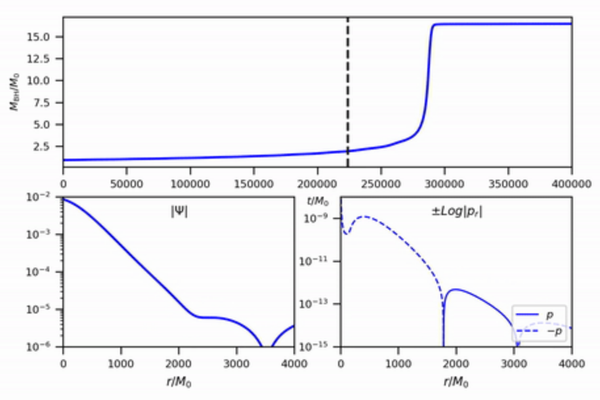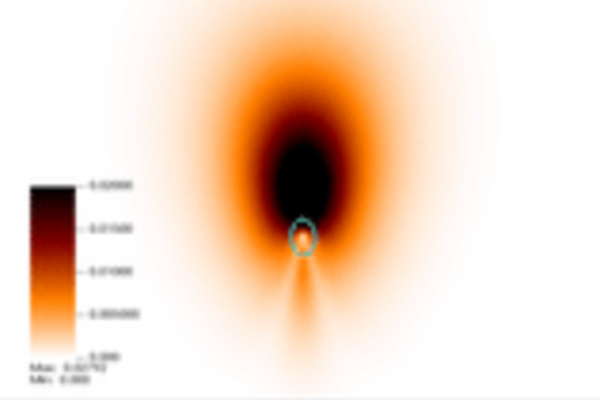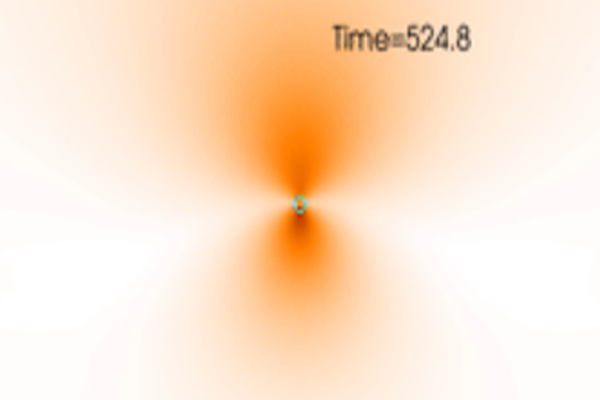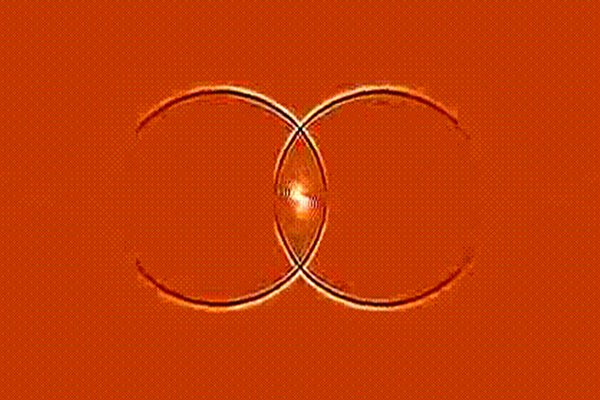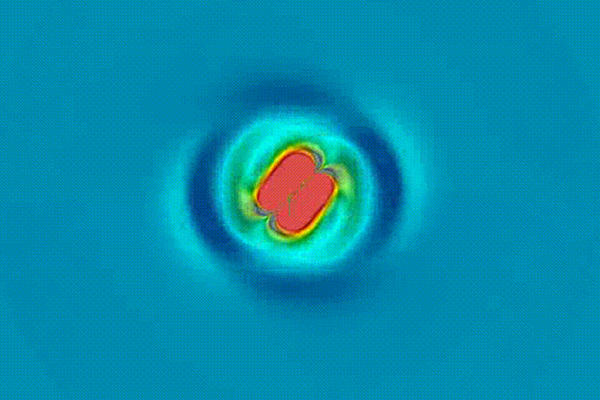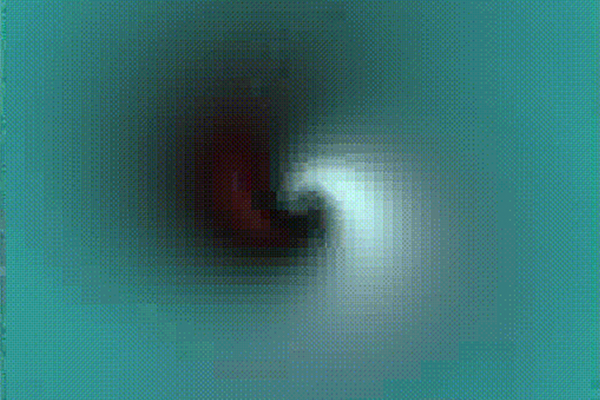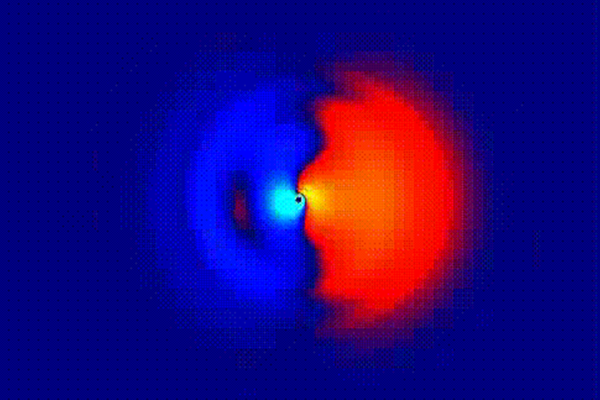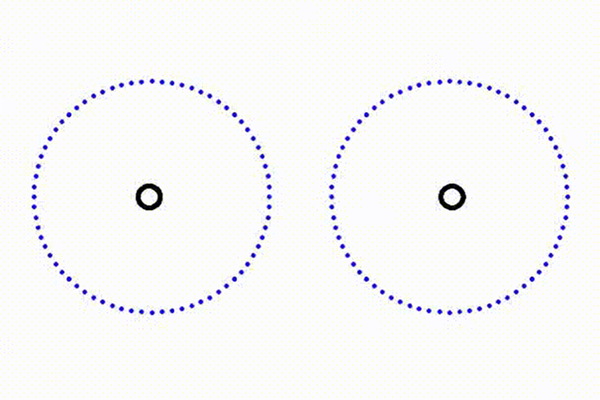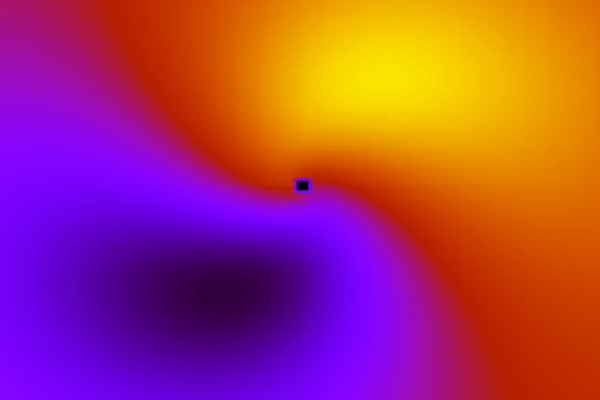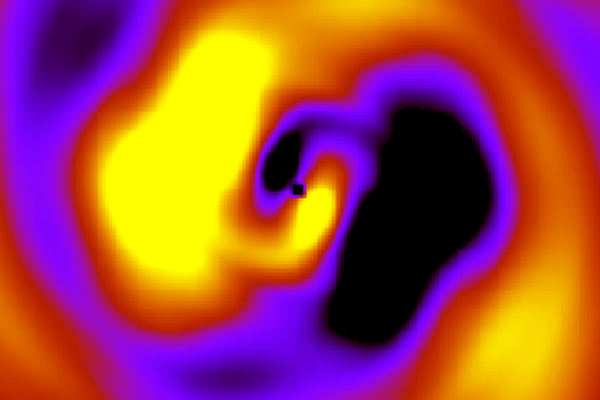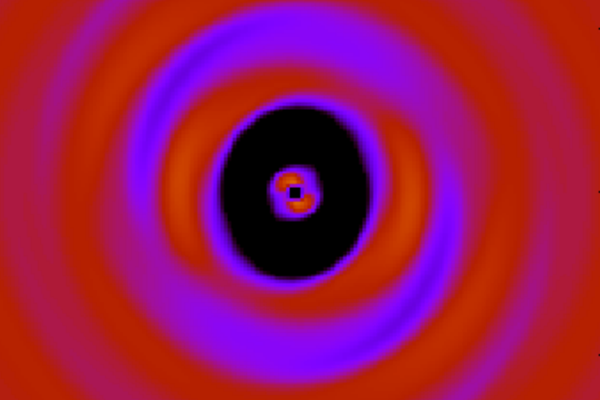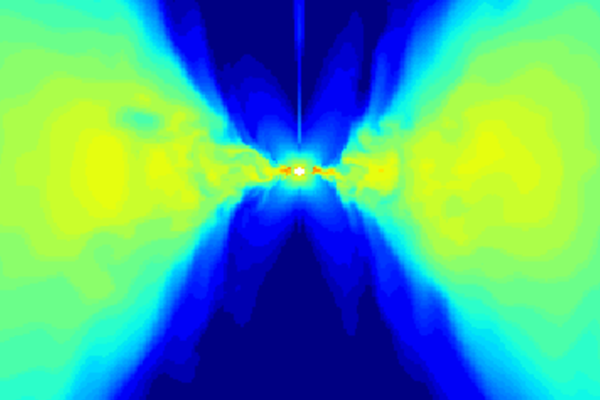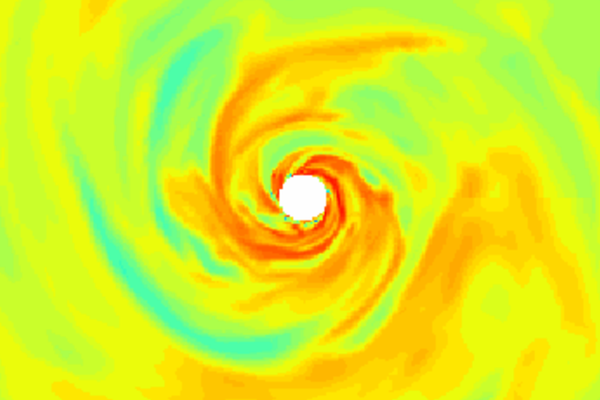Below we provide work data made freely available to the community from the CoG. If you can’t find the material you are looking for or if something is unclear, please contact us.
The oscillation modes of black holes, called quasinormal modes, are fundamental quantities in gravitational-wave astronomy, no-hair tests of General Relativity and even in a gauge-gravity duality context. Here you can find useful material for research, including comprehensive data for the quasinormal mode spectrum of Kerr black holes, and powerful yet simple routines to compute them. The data and routines are freely available, but we would appreciate if you reference the original work.
| RINGDOWN DATA | ||
|---|---|---|
| Description | References | Download |
|
Frequency basis for parametrized black hole QNMs |
||
|
Schwarzschild QNMs Format: 2MωR, 2MωI, error, n |
||
|
Kerr QNM frequencies (Gravitational s=-2) |
l=2 tar file |
|
|
Kerr QNM frequencies (Electromagnetic s=-1) |
l=1 tar file |
|
|
Kerr QNM frequencies (Scalar s=0) |
l=0 tar file |
|
|
KN QNM frequencies (Gravitational modes) |
||
|
QNM Excitation factors (scalar, vectors and tensors) |
||
|
Fits to Kerr QNMs |
||
|
QNM frequencies with 20-digit precision |
||
|
Kerr QNM frequencies and excitation factors |
||
| RINGDOWN ROUTINES | ||
|---|---|---|
| Description | References | Download |
|
Computation of Kerr QNMs with Leaver’s method |
||
|
Computation of Regge - Wheeler and Zerilli equation using Mathematica and xTensor |
Regge & Wheeler, Phys. Rev. 108, 1063 (1957) |
|
|
Computation of QNMs with direct integration |
||
|
Python code to perform bayesian inference based on parallelized nested sampling on numerical relativity or perturbation theory waveforms. |
||
|
Julia code to evolve axial gravitational perturbations to the Vaidya spacetime, as well as to perform bayesian inference using a ringdown model which incorporates nonlinear effects in the background. |
||
|
Set of Mathematica and Julia routines accompanying 2502.18643, including linear perturbations of spherically symmetric spacetimes with stable trapping. |
||
|
Mathematica routines to perform perturbation theory on spherically symmetric backgrounds, exploiting the 2+2 split of Einstein's equations, including the linearized equations of self-gravitating fluids in the BDNK theory of hydrodynamics. |
||
|
Computation of SAdS QNMs using power-series methods |
||
|
QNMs of RNdS black holes |
||
|
Proca fields on a Kerr BH slow-rotation approximation |
||
|
QNMs of Kerr-Newman BHs slow-rotation approximation |
||
|
Massive spin-2 fluctuations slow-rotation approximation |
||
|
Solves the eigenspectrum of unstable modes of a Kerr BHunder massive scalar perturbations through Leaver's continued fraction method |
||
|
Computation of the QNMs of EDGB black hole |
||
|
Computation of quadratic quasinormal modes for plane waves |
||
Superradiant Bounds on Ultralight Fields
See Brito, Cardoso and Pani, Superradiance, Lectures Notes in Physics 906 (2020).
| SUPERRADIANT BOUNDS ON ULTRALIGHT FIELDS | ||
|---|---|---|
| Excluded Region (in eV) | Source | References |
|
5.2x10-13 < mS <6.5x10-12 * |
Direct bounds from absence of spin in Cyg X-1 |
|
|
3.8×10−14 < mS < 2x3.4×10−11 |
Indirect bounds from BH mass-spin measurements |
arXiv:1411.2263 |
|
1.2×10−13 < mS < 1.8×10−13 |
Null results from blind all-sky searches for continuous GW signals |
|
|
6.4×10−13 < mS < 8.0×10−13 |
Null results from searches for continuous GW signals from Cygnus X-1 |
|
|
2.0×10−13 < mS < 3.8×10−13 |
Negative searches for a GW background |
|
|
5×10−13 < mS < 3×10−12 |
Bounds from pulsar timing |
|
|
2.9×10−21 < mS < 4.6×10−21 |
Bounds from mass and spin measurement of M87 with EHT |
|
* See Brito, Cardoso and Pani, Superradiance, Lectures Notes in Physics 906 (2020).
Amplification Factors in Kerr and Routines
Superradiant amplification of massless waves scattering off Kerr black holes is an important phenomena in curved spacetime. Details of the process can be found in an outstanding work by Press and Teukolsky (ApJ193, 443 (1974)), but extensive tables and routines to compute them are lacking. We provide here such data. The routines are freely available, but we would appreciate if you refer to the original work.
| AMPLIFICATION FACTORS DATA AND ROUTINES | ||
|---|---|---|
| Amplification Factors Data | References | Download |
|
Amplification factors of massless fields |
||
|
Amplification Factors Routines |
References |
Download |
|
Amplification factors of the superradiant |
||
|
Amplification factors of the superradiant |
||
Gravitational Waves from Viscous Stars
| GRAVITATIONAL WAVES FROM VISCOUS STARS | ||
|---|---|---|
| Description | References | Download |
|
Notebook handling axial-led fluctuations of a slowly rotating star in the BDNK hydrodynamic theory. Requires RGtensors package. |
||
|
Julia routines to integrate stellar structure equations and axial perturbation equations derived in the previous notebook, and to extract reflectivities. |
||
Cardoso et al. Metric functions and perturbations equations for black hole solutions in Effective Field Theories. Phys. Rev. Lett. 121: 251105 (2018). [arxiv:1808.08962]
Readme (Rich Text Format)
Effective Potencials Webpage (Mathematica Notebook)
EFT BH Geodesics (Mathematica Code)
EFT BH Metric (Mathematica Code)
Solutions of Einstein's equations can be obtained analytically in a handful of cases. Generically, it requires sophisticated techniques. Here we show some simple routines (under the form of notebooks or C++ routines) to compute (stationary) hairy black hole solutions in massive theories of gravity and static neutron star structure in alternative theories of gravity. Finally, we also make available a 1+1 code to evolve a spherically symmetric, scalar wavepacket in AdS spacetimes. The routines are freely available, but we would appreciate if you reference the original work.
| NONLINEAR SOLUTIONS | ||
|---|---|---|
| Description | References | Download |
|
Rotating black holes in galactic haloes |
P. G. S. Fernandes and V. Cardoso, to appear (2025) |
|
|
Hairy BHs in massive gravity |
||
|
NSs in scalar-tensor gravity |
||
|
Scalar Field Collapse in AdS |
Lopes et al. |
|
|
Kerr black holes with scalar hair |
||
|
(i) computes and solves Einstein's equations |
||
| Boson Stars | ||
|---|---|---|
| Description | References | Download |
|
Spherically symmetric boson stars |
||
Tidal Love numbers for exotic compact objects (boson stars, gravastars, wormholes, mirrors).
| TIDAL LOVE NUMBERS | ||
|---|---|---|
| Description | References | Download |
|
Love numbers of ECOs. |
||
|
Basis for parametrized black hole TLNs. |
||
Radiation from Plunging Particles
Gravitational radiation from point-like particles plunging into black holes has a very long history, and is known to reproduce accurately even highly non-linear processes like equal mass black hole collisions. We will gather here some Mathematica routines to compute gravitational radiation from the plunging of particle into black holes, both in GR and in some modified theories of gravity.
| RADIATION FROM PLUNGING PARTICLES | ||
|---|---|---|
| Description | References | Download |
|
Radiation from a pointlike particle plunging |
||
|
Radiation from a pointlike particle plunging |
||
|
Perturbation of Schwarzschild black hole |
||
Gravitational Waves from Boson Clouds
Here you can find routines that can be used to compute the flux in gravitational waves emitted by a scalar cloud around a Kerr black hole. Some computations make use of the Black Hole Perturbation toolkit (bhptoolkit.org). We also use results from arXiv:0306120, arXiv:0705.2880 and arXiv:1312.2326. The data generated by this routine served as input for the python package gwaxion (pypi.org/project/gwaxion).
| GRAVITATIONAL WAVES FROM BOSON CLOUDS | ||
|---|---|---|
| Description | References | Download |
|
Computation of gravitational-wave flux from a scalar cloud. |
||
|
Scalar and gravitational fluxes from EMRIs in scalar environments. |
||
EMRIs in Astrophysical Environments
Here you can find routines to compute the radiation emitted by an extreme-mass-ratio inspiral in spherically-symmetric, non-vacuum black-hole spacetimes. We specialize to the case of a black hole within a halo of matter based on the solution found in arXiv:2109.00005, but you can adapt it to other backgrounds.
| EMRIs in Astrophysical Environments | ||
|---|---|---|
| Description | References | Download |
|
Time-domain code |
||
|
Frequency-domain code |
||
Video Files
Parasitic black holes. The swallowing of a fuzzy dark matter soliton. Time evolution of BH mass (top panel), scalar field (bottom left), and energy flux (bottom right). Initial boson star mass is 15 times heavier than initial black hole mass. Initial boson star size is 600 times larger than black hole radius. arXiv:2207.09469v1.
Piercing of boson stars by a black hole (I). A black hole of unit mass colliding with a boson star of mass 0.53. The collision happens at 50% the speed of light. arXiv:2206.00021.
Piercing of boson stars by a black hole (II). A black hole of unit mass colliding with a boson star of mass 0.53. The collision happens at 50% the speed of light. Right panel: a black hole of mass 0.1 colliding with a boson star of mass 0.53. The collision happens at 50% the speed of light. arXiv:2206.00021.
High energy black hole collisions. The collision of two boosted black holes (v=0.75c in the center of mass frame), with a finite impact parameter in asymptotically flat spacetime. About 24% of the center of mass frame can be released as radiation, for this collision. The final hole is nearly maximally spinning. The intensity of the color refers to the amplitude of the gravitational waves as measured by Ψ4. arXiv:0907.1252.
Black holes in a box. The inspiral and coalescence of two black holes, with total mass M, inside a confining box of radius 48 M. Out- and in-going waves are measured respectively by Ψ4 and Ψ0. arXiv:1004.4633.
Black hole bombs I: Scalar fields. The time evolution of a massive scalar field around a highly spinning black holes. The scalar field is initially in a bound state, and continues to be for thousands of orbital periods. Colors depict field intensity. arXiv:1212.0551.
Black hole bombs II: Vector fields. The time evolution of a massive vector field around a highly spinning black holes. The vector field is initially a generic gaussian. Colors depict field intensity. arXiv:1212.0551.
Black hole collisions in de Sitter spacetime. Two black holes of sufficiently large mass in de Sitter spacetime would, upon merger, give rise to too large a black hole to fit in its cosmological horizon, resulting in a naked singularity. We here test such a configuration. Even though the initial separation is very small, we find that the holes move away from each other, with a proper separation increasing as the simulation progresses. arXiv:1204.2019.
Bursts of light from axion clouds (I). The evolution of an axion Phi of mass mu=0.2 and of the electromagnetic scalar E2-B2 in the background of a Kerr BH (a=0.5). The initial axion configuration describes a cloud around a spinning black hole, grown by superradiance.
When superradiance is turned off and the initial amplitude of the axion is small, any vector perturbation dies off quickly. arXiv:1811.04950.
Bursts of light from axion clouds (II). When superradiance is turned off and the initial amplitude of the axion is large, an instability is triggered and gives rise to a EM burst. arXiv:1811.04950.
Bursts of light from axion clouds (III). When superradiant growth is included, even a small initial axion amplitude eventually grows large and triggers EM bursts, blasts of laser-like electromagnetic radiation. This blasts lowers the axion to sub-critical values, until superradiance dominates again. arXiv:1811.04950.
Audio Files
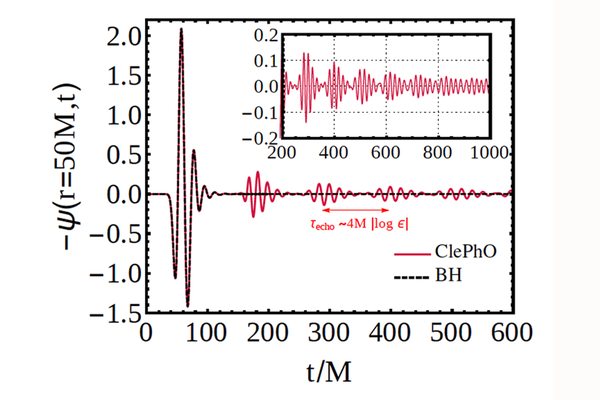
Echoes from quasicircular inspiral of a mass ratio 1:100 binary. Massive object is a ClePhO (horizonless object). arXiv:1602.07309; arXiv:1608.08637; arXiv:1904.05363.
Audio data:
audio q=[1 .. 100] quasi-circular echoes;
wave 22, Schwarzschild Radius 100

